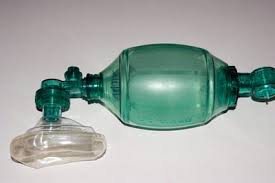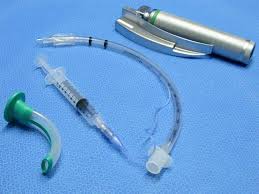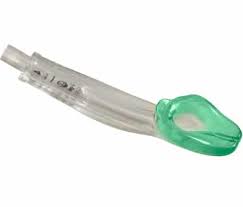Connecticut recently added supraglottic airways to the BLS scope of practice. That means basic EMTs (emergency medical technicians with considerably less training than paramedics) with the approval of their sponsor hospital medical director, no longer have to rely on bag-valve-mask ventilation to breathe for patients in cardiac arrest. Bag valve mask ventilation for those not familiar, means sealing a plastic mask over a patient’s mouth with one hand firmly enough that no air escapes, and with the other hand squeezing a bag that sends air into the patient’s mouth and down their throat into their lungs. If the seal is not held tightly the air escapes around the mouth and the action is ineffective. Also, the EMT must tilt the patient’s head at the proper angle so the airway is kept open and the air goes into the windpipe (Trachea) and not into the food pipe (esophagus) which leads to the stomach. Bag valve mask ventilation, while a basic level skill is very difficult to do well. Ideally, two people perform the skill. One tilting the head and holding the seal with two hands, while the other squeezes the bag. This of course requires at least three rescuers to care for a cardiac arrest patient as the third rescuer is needed for the most important job — chest compressions. A supraglottic airway involves opening the patient’s mouth and inserting a tube that secures itself just above the vocal cords, The bag valve mask is attached to this tube instead of the plastic mask, and the provider squeezes the bag. Wall-la! There is no need to maintain a tight seal as a face mask is not used, Supraglottic airways are easy to insert and once inserted, way easier to use than trying to keep the seal on the plastic mask.
When I started as a paramedic, the airway gold standard was an endotracheal, or ET tube. This involved using a device called a laryngoscope to open the patient’s mouth, sweep the tongue out of the way, identity the vocal cords which the laryngoscope light should do, and then successfully pass the tube through the chords to the proper depth, inflate a balloon to secure the tube in place, secure the tube off with a mouth guard and begin ventilating, hoping the tube does not get moved out of place, either too far down so only one lung gets inflated or pulled back outpast the chord so the air goes into the stomach and not the lungs. Both very bad. The big danger with the ET tube is, of course, missing the chords and the tube ending up in the stomach and this not being recognized. We didn’t have capnography (End Tidal CO2 monitoring) back then, Capnography measures the carbon dioxide expelled with each ventilation. A capnography device is attached to the end of the tube between the tube and the bag-valve-mask. A thin sampling line connects the device to the cardiac monitor. If the tube is in the trachea (good), you get a wave form and a positive number (30 is great, but even 10 will tell you are in the right place. If the tube is in the stomach, the ETCO2 reading is 0 and the waveform is flatline. You see this and you know to immediately take the tube out.
I love intubating (the term for placing an ET tube). When I began, it was a skill only medics could do and once I did one, it was like losing your virginity. You were a paramedic now. You did what only other medics and doctors could do. Look at me! Whoo Hoo! The problem with intubating, I found, beside the occasional difficulty of placing the tube, particularly on patients with thick or nonexistent necks, was that it took so damn long to set up. I would arrive at the code as the only paramedic and have to spend two minutes, my back turned to the patient, just opening up my airway kit, taking out the tube, stylet, syringe, and mouth guard, testing the tube, before getting down on my knees and hoping I would see the chords on first look and pass the tube on first attempt. Joy if you did, but tension if you were having difficulty. All eyes on you and you were failing the patient. You could only look for a brief period, and then you had to resume ventilating with the bag-valve mask. If we couldn’t get the tube after a few tries (later limited to just 2), we went to our backup airway — the supraglottic combi-tube. It was somewhat of a mark of shame if you brought in a patient with a combi-tube. What? You couldn’t get the ET?
In time, things started to charge. Supraglottics became alternative airways instead of backup airways. It became acceptable to go to a supraglottic first. Patient three hundred pounder in a hospital bed, wedged in the corner of a hoarder’s house, sure, just drop a supraglottic. I found supraglottics to be quick and easy and hassle free with great ETCO2 readings showing that I was getting the job done, effectively ventilating my patient. Pat on the back.
I still like to intubate, but I have no shame about quickly dropping (inserting) an Igel, our latest supraglottic airway, which is even simpler than the combitube.
When I first heard the proposal at our regional medical advisory meeting to let EMTs use supraglottics, I was one of the few medics in the room to say I was all for it. I have shown up at codes (cardiac arrests) and seen patients with giant inflated bellies as I watched EMTs struggle to effectively bag a patient. I believed if they had supraglottics, they were fully capable of inserting one and effectively bagging the patient. It would be better for the patient. Well, hooray for all the Emergency EMS medical Control Doctors who eventually agreed and passed this proposal. I know at my hospital where I am the EMS coordinator, we will grant approval to those EMS services that want to let their EMTs do this skill.
This is all a foreword to a new paper just released by the prestigious Journal of the American Medical Association and written by the nearly equally prestigious Henry Wang who has been the leading researcher of EMS airways with multiple publications to his credit, spanning decades of research. Studying over 440,000 EMS advanced airway calls between 2011 and 2022, Wang found that ET attempts decreased from 87.3% of cardiac arrest calls to 55.1% and those while supraglottic attempts increased from 25.1% to 61.0%. (Note on some calls, ET was tried, then followed with a Supraglottic). Startling to imagine back in my early days, but believable based on my experience. Good news for patients, who I believe are now likely being better ventilated in those crucial early moments of an EMS response.
The study did not examine patient outcomes to determine whether patients who received supraglottic airways did better or worse than those who received ET. Subject for another trial.
You can read the full study here.
https://jamanetwork.com/journals/jamanetworkopen/fullarticle/2822720
Bottom Line for me is Supraglottic airways are easier to insert than endotracheal tubes and are more effective at ventilating patients than bag-valve masks. I strongly believe BLS EMTs are capable of inserting supraglottic airways. Let’s hope that their use by basic EMTs in Connecticut improves patient outcomes.




